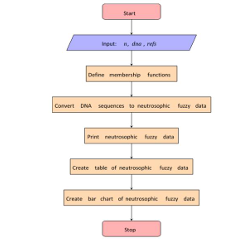Integration between Bioinformatics Algorithms and Neutrosophic Theory
Keywords:
DNA; Neutrosophic Inference Model; Sequence Analysis; Artificial Intelligence.Abstract
This paper presents a neutrosophic inference model for bioinformatics. The model is
used to develop a system for accurate comparisons of human nucleic acids, where the new nucleic
acid is compared to a database of old nucleic acids. The comparisons are analyzed in terms of
accuracy, certainty, uncertainty, neutrality, and bias. The proposed system achieves good results
and provides a reliable standard for future comparisons. It highlights the potential of neutrosophic
inference models in bioinformatics applications. Data mining and bioinformatics play a crucial role
in computational biology, with applications in scientific research and industrial development.
Biological analysts rely on specialized tools and algorithms to collect, store, categorize, and analyze
large volumes of unstructured data. Data mining techniques are used to extract valuable
information from this data, aiding in the development of new therapies and understanding genetic
relationships between organisms. Recent advancements in bioinformatics include gene expression
tools, Bio sequencing, and Bio databases, which facilitate the extraction and analysis of vital
biological information. These technologies contribute to the analysis of big data, identification of
key bioinformatics insights, and generation of new biological knowledge. Data collection, analysis,
and interpretation in this field involves the use of modern technologies such as cloud computing,
machine learning, and artificial intelligence, enabling more efficient and accurate results.
Ultimately, data mining and bioinformatics enhance our understanding of genetic relationships, aid
in developing new therapies, and improve healthcare outcomes.
Downloads

Downloads
Published
Issue
Section
License
Copyright (c) 2024 Neutrosophic Sets and Systems

This work is licensed under a Creative Commons Attribution 4.0 International License.






